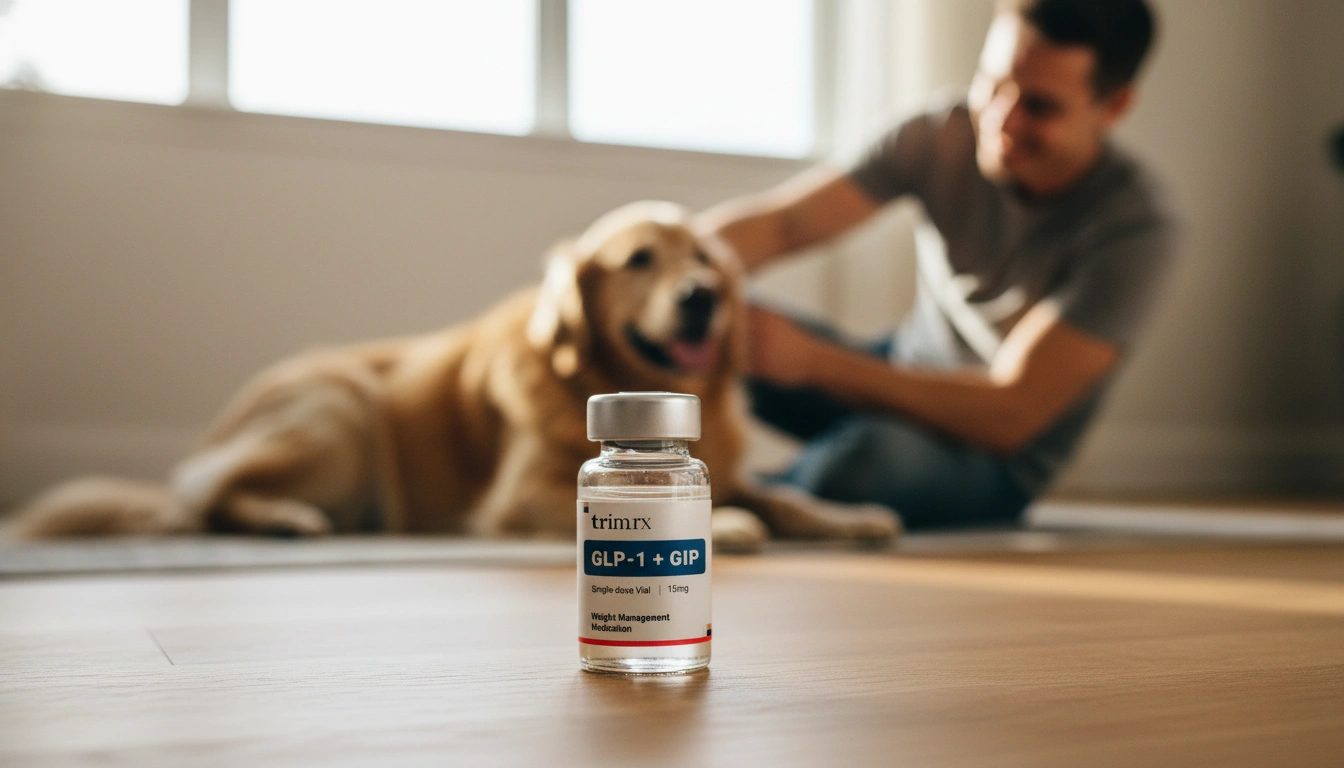What Does GLP-1 Hormone Do? Understanding Its Role in Weight Management and Diabetes

Introduction
Did you know that around 34 million Americans have diabetes, and the numbers are rising? This staggering statistic underscores our urgent need to better understand the hormones that regulate our metabolism and appetite. Among these, GLP-1 stands out as a critical hormone produced in our intestines, with effects that extend far beyond blood sugar control.
GLP-1 is part of a group of hormones known as incretins, which significantly influence insulin secretion and appetite regulation. First identified in the early 1980s, this hormone has gained attention in recent years for its therapeutic potential, particularly in treating type 2 diabetes and obesity.
In this blog post, we will delve into the various functions of GLP-1, how it interacts with other hormones, its role in weight loss, and how TrimRx leverages this knowledge to provide personalized weight loss solutions. We’ll also discuss how our medically supervised programs can help you achieve sustainable weight loss through science and empathy.
Together, we will explore:
- The Biology of GLP-1: Understanding how this hormone is produced and its physiological effects.
- GLP-1 and Appetite Regulation: How GLP-1 influences hunger and satiety.
- The Role of GLP-1 in Diabetes Management: Its significance in blood sugar control.
- GLP-1 and Weight Loss: Exploring the implications for obesity treatment.
- TrimRx’s Approach: How we incorporate GLP-1 into our personalized weight loss programs.
By the end of this post, we hope to empower you with knowledge about GLP-1, its importance in your health journey, and how TrimRx can support you in achieving your weight loss goals.
We often hear about the importance of hormones in regulating our health, but few get the spotlight like glucagon-like peptide-1 (GLP-1). This remarkable hormone plays a pivotal role in managing blood sugar levels and influencing our appetite, making it a significant player in the realms of weight management and diabetes treatment. If you’ve ever wondered, “what does GLP-1 hormone do?” you’re in the right place. In this post, we will explore the multifaceted functions of GLP-1, its implications for health, and how it fits into our personalized weight loss solutions at TrimRx.
The Biology of GLP-1
GLP-1 is a peptide hormone secreted primarily by L-cells in the lining of the small intestine in response to food intake. When we eat, GLP-1 is released into the bloodstream within 10 to 15 minutes, signaling various physiological responses. Importantly, GLP-1 is derived from the proglucagon molecule, which is also responsible for producing other hormones, including glucagon.
Key Functions of GLP-1
- Insulin Secretion: One of the primary roles of GLP-1 is to stimulate the pancreas to release insulin, a hormone that lowers blood sugar levels. This action is particularly important after meals when blood sugar spikes occur.
- Inhibition of Glucagon: GLP-1 also inhibits the secretion of glucagon, a hormone that raises blood sugar levels. By reducing glucagon levels, GLP-1 helps maintain a balanced blood sugar profile.
- Slowing Gastric Emptying: Another critical function of GLP-1 is to slow the emptying of the stomach. This means that food is digested more slowly, leading to a gradual release of glucose into the bloodstream, which helps prevent spikes in blood sugar.
- Regulation of Appetite: GLP-1 acts on the brain’s appetite centers, promoting feelings of fullness and reducing cravings. This is particularly beneficial for individuals looking to manage their weight.
Summary of Biological Functions
- Stimulates insulin secretion from the pancreas.
- Inhibits glucagon release, contributing to lower blood sugar levels.
- Slows gastric emptying, leading to more stable blood sugar responses.
- Promotes satiety, reducing hunger and food intake.
Understanding these functions is essential as we explore how GLP-1 can be integral in weight management and diabetes treatment.
GLP-1 and Appetite Regulation
The appetite-suppressing effects of GLP-1 are one of its most significant benefits, especially for those struggling with weight management. When GLP-1 is released after a meal, it sends signals to the brain that help us feel full, reducing the likelihood of overeating.
Mechanism of Action
GLP-1 interacts with various brain regions involved in appetite regulation, including the hypothalamus. Here’s how it works:
- Increased Satiety: GLP-1 enhances the sensation of fullness after meals, which can help decrease total caloric intake.
- Reduced Food Cravings: By regulating appetite, GLP-1 can help mitigate cravings for unhealthy foods, making it easier to stick to a balanced diet.
Implications for Weight Loss
For individuals looking to lose weight, increased GLP-1 levels can be a game changer. By promoting satiety and reducing hunger, GLP-1 can help individuals adhere to their dietary plans more effectively, supporting their weight loss goals.
At TrimRx, we understand the importance of these mechanisms. Our personalized weight loss programs take into account how hormones like GLP-1 impact your unique weight loss journey.
If you are curious about how GLP-1 can work for you, we invite you to take our free assessment quiz to explore our personalized treatment options. Take our quiz here.
The Role of GLP-1 in Diabetes Management
GLP-1 plays a crucial role in managing type 2 diabetes (T2D), a condition characterized by insulin resistance and elevated blood sugar levels. Given its ability to stimulate insulin secretion and inhibit glucagon, GLP-1 is a key target for diabetes treatment.
GLP-1 Agonists
GLP-1 receptor agonists are medications that mimic the action of GLP-1. These drugs have been developed to provide sustained stimulation of insulin release, especially after meals. Some well-known GLP-1 agonists include:
- Semaglutide (Ozempic®, Wegovy®)
- Liraglutide (Victoza®)
- Dulaglutide (Trulicity®)
These medications have shown significant efficacy in lowering blood sugar levels and promoting weight loss in individuals with T2D.
Mechanisms in Diabetes Management
- Improved Glycemic Control: By enhancing insulin secretion and reducing glucagon levels, GLP-1 agonists help maintain stable blood sugar levels, which is vital for managing diabetes.
- Weight Loss Benefits: Many patients experience weight loss as a side effect of GLP-1 agonists, making them a two-in-one solution for those with T2D who also struggle with obesity.
- Cardiovascular Protection: Recent studies suggest that GLP-1 agonists may also provide cardiovascular benefits, further supporting their use in diabetic patients.
Summary of GLP-1 in Diabetes Management
- Enhances insulin secretion in response to meals.
- Inhibits glucagon release, helping lower blood sugar levels.
- Supports weight loss, addressing two critical aspects of T2D management.
- Potential cardiovascular benefits, enhancing overall health.
The integration of GLP-1 in diabetes management is a testament to its importance in modern healthcare. At TrimRx, we prioritize safe and effective solutions, ensuring that our patients receive comprehensive care that includes monitoring and managing their metabolic health.
GLP-1 and Weight Loss
The relationship between GLP-1 and weight loss has garnered considerable attention, particularly given the rising rates of obesity in the United States. Research indicates that individuals with higher levels of GLP-1 tend to have better appetite control and are more successful in weight loss efforts.
How GLP-1 Influences Weight Loss
- Appetite Suppression: As previously noted, GLP-1 enhances feelings of fullness, which helps reduce overall caloric intake.
- Thermogenesis: There is emerging evidence suggesting that GLP-1 may play a role in energy expenditure, promoting thermogenesis—the process in which the body generates heat and burns calories.
- Behavioral Changes: GLP-1’s effects on appetite can lead to long-term changes in eating behaviors, making it easier for individuals to adhere to healthier dietary patterns.
TrimRx’s Personalized Weight Loss Programs
At TrimRx, we understand that weight loss is not a one-size-fits-all solution. Our personalized approach involves using GLP-1 in conjunction with lifestyle modifications to create a comprehensive weight loss plan. Our programs include:
- Doctor Consultations: We provide ongoing medical supervision to ensure your weight loss journey is safe and effective.
- Personalized Treatment Plans: After taking our free assessment quiz, we tailor our approach to fit your unique needs.
- Unlimited Support: Our team is here to support you every step of the way, offering guidance and encouragement.
If you’re ready to take charge of your weight loss journey, we encourage you to take our free assessment quiz and discover how our personalized programs can help you achieve your goals.
Conclusion
GLP-1 is a remarkable hormone that plays a multifaceted role in our health, particularly in the areas of appetite regulation, blood sugar management, and weight loss. By understanding what GLP-1 does, we can appreciate its significance in treating conditions like obesity and type 2 diabetes.
At TrimRx, we are dedicated to helping individuals embrace healthier lifestyles through personalized, medically supervised weight loss solutions. By integrating the science of GLP-1 into our programs, we can offer our patients effective pathways to achieve their weight loss goals safely and sustainably.
We invite you to reach out to us to learn more about how GLP-1 can support your journey to better health. Whether you’re looking to lose weight, manage diabetes, or simply enhance your overall well-being, we are here to help every step of the way.
FAQ
What is GLP-1?
GLP-1 is a peptide hormone produced in the intestines that helps regulate insulin secretion, appetite, and gastric emptying.
How does GLP-1 help in weight loss?
GLP-1 promotes feelings of fullness and reduces cravings, making it easier to manage food intake and adhere to a healthy diet.
What are GLP-1 agonists?
GLP-1 agonists are medications that mimic the action of GLP-1, enhancing insulin secretion and helping to lower blood sugar levels.
Can GLP-1 be used for diabetes management?
Yes, GLP-1 plays a crucial role in managing type 2 diabetes by improving glycemic control and promoting weight loss.
How can TrimRx help with weight loss?
TrimRx offers personalized weight loss programs that include doctor consultations, treatment plans involving GLP-1, and unlimited support to help you achieve your goals.
We hope this article has provided you with valuable insights into the role of GLP-1 in weight management and diabetes. If you’re ready to start your journey with TrimRx, take our free assessment quiz today!

Transforming Lives, One Step at a Time
Keep reading
7 Tips for Sticking to GLP-1 Injection Schedules
Seven practical strategies to keep weekly GLP‑1 injections on schedule—pick a routine day, set reminders, manage side effects, rotate sites, and avoid missed doses.
Custom GLP-1 Dosing for Kidney Disease
Personalized GLP-1 dosing for CKD patients with monitoring, dehydration and hypoglycemia risk mitigation, and guidance across all kidney disease stages.
Semaglutide vs Tirzepatide: Approved Uses
Two leading diabetes and weight-loss drugs differ in FDA-approved benefits — one adds heart, kidney and liver protection; the other treats obstructive sleep apnea.



